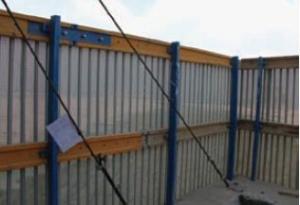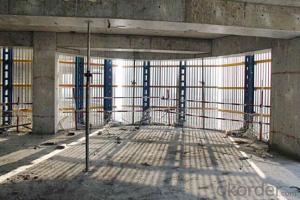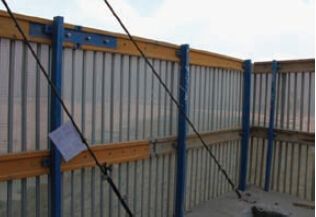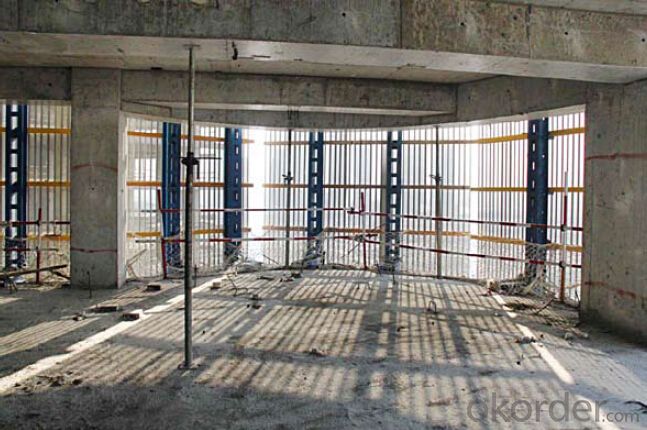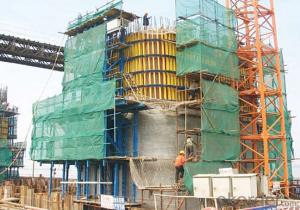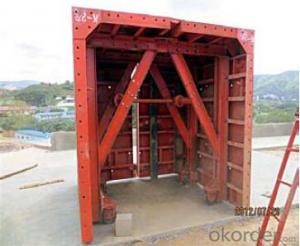Protection Platform for Formwork and Scaffolding System
- Loading Port:
- Tianjin
- Payment Terms:
- TT OR LC
- Min Order Qty:
- 50 m²
- Supply Capability:
- 1000 m²/month
OKorder Service Pledge
OKorder Financial Service
You Might Also Like
Protection Platform PP-50
A kind of new type construction protection system, applying operating platform and safer job
location for construction corps.
Characteristics:
◆ Easy and quick assembling.
◆ Lifted as a group, it is rapid and economic.
◆ Auto-climbing
◆ A safe and reliable anchor system
1. Composition
2. Assembly process of anchor system
(1) Embed V-climbing cone and anchor plate into the slab.
(2) Fix anchor shoe on the slab by tensile bolt.
(3) The fixed anchor shoe.
◆ High work efficiency with work platform and unload platform
◆ High light transmittance with the hollow block


- Q: How does steel formwork affect the structural integrity of a building?
- Steel formwork is a construction technique that utilizes steel molds to create the desired shape and structure of concrete elements within a building. Its role in the construction process is pivotal and it impacts the structural integrity of a building in various aspects. To begin with, steel formwork acts as a robust and rigid support system for the wet concrete during pouring and setting. Its strength guarantees that the concrete retains its desired shape and prevents any deformation or collapse. This is particularly crucial for structural elements such as beams, columns, and walls, as it ensures their correct alignment and stability. Moreover, steel formwork allows for precise and accurate construction. The molds can be fabricated with exceptional precision, resulting in concrete elements with accurate dimensions and shapes. This precision is vital for maintaining the structural integrity of the building, as even the slightest deviation or misalignment can compromise its overall strength and stability. Furthermore, steel formwork produces a smooth surface finish for the concrete. This smoothness is not only aesthetically pleasing but also contributes to the structural integrity of the building. A smooth surface reduces the chances of cracks, voids, or air pockets in the concrete, which can weaken its strength and durability. In addition, steel formwork offers durability and reusability. Unlike other types of formwork such as wood or plastic, steel formwork can withstand multiple uses without compromising its structural integrity. This reusability not only saves construction costs but also ensures consistency in the quality of the concrete elements throughout the building. Lastly, steel formwork enhances the overall structural stability of the building. The use of steel molds creates a rigid framework that evenly and efficiently distributes the loads. This distribution minimizes the risk of localized stress concentrations, thereby improving the structural integrity of the building and increasing its resistance to external forces such as wind, earthquakes, or heavy loads. In conclusion, steel formwork has a significant positive impact on the structural integrity of a building. It provides a strong support system, ensures precision and accuracy, offers a smooth surface finish, provides durability and reusability, and enhances overall structural stability. All of these factors contribute to the strength, stability, and longevity of the building, making steel formwork an essential component in modern construction practices.
- Q: Are there any specific maintenance requirements for steel formwork systems?
- Yes, there are specific maintenance requirements for steel formwork systems. Steel formwork systems are used in construction to create temporary molds or frameworks for pouring concrete. These systems are designed to be durable and long-lasting, but regular maintenance is necessary to ensure their proper functioning and longevity. One important maintenance requirement for steel formwork systems is to regularly clean and remove any debris or concrete residue from the surfaces. This can be done by using a wire brush or high-pressure water jet to remove any hardened concrete or build-up. Cleaning the formwork prevents the accumulation of materials that can affect the quality and appearance of future concrete pours. Additionally, it is crucial to inspect the steel formwork system for any signs of damage or wear. This includes checking for cracks, dents, or rust on the steel components. If any damage is found, it should be repaired promptly to prevent further deterioration and to maintain the structural integrity of the formwork. Another maintenance requirement is to lubricate the moving parts of the steel formwork system. This includes hinges, locks, and adjustable parts that allow for easy assembly and disassembly. Lubrication helps to prevent corrosion, ensures smooth operation, and prolongs the lifespan of the formwork system. Furthermore, regular inspection of the formwork system's alignment and stability is necessary. This ensures that the formwork remains level and securely in place during concrete pouring. Any misalignment or instability should be addressed immediately to prevent accidents or structural issues during construction. Overall, proactive maintenance of steel formwork systems is essential to ensure their proper functioning, durability, and safety. Regular cleaning, inspection, repair, and lubrication are key to maintaining the quality and longevity of these systems, ultimately contributing to successful construction projects.
- Q: How does steel formwork accommodate for different concrete curing durations?
- Steel formwork can accommodate for different concrete curing durations by providing a sturdy and durable structure that can support the weight of the concrete during the curing process. The steel formwork is designed to be reusable, allowing for easy removal once the concrete has cured to the desired strength. This flexibility in formwork material enables construction projects to adapt to different curing durations without compromising the structural integrity of the concrete.
- Q: Can steel formwork be used in retail or commercial construction projects?
- Retail or commercial construction projects can benefit greatly from the use of steel formwork. This versatile and durable solution is ideal for creating concrete structures, offering numerous advantages. With its high reusability, excellent dimensional stability, and ability to handle high concrete pressures, steel formwork is a reliable choice. In these types of projects, steel formwork can be utilized for various applications including columns, walls, beams, slabs, and staircases. It provides a strong framework, ensuring accurate and smooth concrete placement, resulting in top-notch finishes. Moreover, steel formwork can be easily customized and adjusted to meet different project requirements, making it suitable for complex architectural designs. In addition to its flexibility, steel formwork also brings significant time and cost savings to construction projects. Its reusability minimizes the need for frequent formwork replacements, leading to reduced material and labor costs. The use of steel formwork further enhances construction efficiency by allowing for quick assembly, disassembly, and repositioning of formwork components. Overall, steel formwork is a dependable and efficient choice for retail or commercial construction projects, providing the necessary strength and flexibility for such applications.
- Q: How does steel formwork help in achieving a high-quality finish?
- Steel formwork helps in achieving a high-quality finish due to its ability to provide a strong and rigid structure for concrete placement. Its smooth and non-absorbent surface prevents the formation of air bubbles, resulting in a smooth and even finish. Additionally, steel formwork allows for precise and accurate shaping and alignment, ensuring the desired dimensions and contours of the final concrete product.
- Q: What are the different types of safety precautions required when working with steel formwork?
- When working with steel formwork, there are several safety precautions that need to be followed to ensure the safety of workers. Some of the different types of safety precautions required include: 1. Personal Protective Equipment (PPE): Workers should wear appropriate PPE such as safety helmets, safety glasses, gloves, and safety shoes to protect themselves from potential hazards like falling objects or sharp edges. 2. Fall Protection: Fall protection measures like guardrails or safety harnesses should be installed to prevent workers from falling off elevated platforms or structures. 3. Adequate Training: Workers should receive proper training on the safe handling and use of steel formwork equipment. They should be educated about the potential risks associated with the work and how to mitigate them. 4. Proper Installation and Maintenance: Steel formwork should be correctly installed and regularly inspected for any defects or damage. Any faulty or damaged parts should be repaired or replaced to ensure the structural integrity of the formwork. 5. Secure Storage: When not in use, steel formwork should be stored in a safe and designated area to prevent accidents caused by improper storage or falling objects. 6. Communication and Signage: Clear communication and signage should be in place to inform workers about potential hazards, safety procedures, and emergency exits. 7. Proper Lifting Techniques: Workers should be trained on proper lifting techniques to avoid strains or injuries when handling heavy steel formwork components. 8. Fire Safety: Fire extinguishers and other fire safety equipment should be readily available on-site to address any fire emergencies. 9. Electrical Safety: If working near electrical equipment or power lines, workers should be trained on electrical safety procedures and take necessary precautions to prevent electrical hazards. 10. Regular Safety Meetings and Inspections: Regular safety meetings should be conducted to address any safety concerns or issues. Additionally, inspections should be carried out periodically to identify and rectify any potential safety hazards. By adhering to these safety precautions, workers can minimize the risk of accidents and injuries while working with steel formwork, ensuring a safe working environment.
- Q: What are the different types of accessories used in steel formwork systems?
- Steel formwork systems commonly utilize a variety of accessories to enhance support, stability, and usability during construction. One such accessory is the formwork prop, also called a shore or post, which is adjustable in height and provides vertical support for formwork panels or beams, effectively distributing the weight of the concrete. Another frequently employed accessory in steel formwork systems is the formwork beam, which horizontally supports formwork panels while adding strength and stability. Depending on project requirements, these beams can be made of steel or aluminum. Formwork clamps play a crucial role in steel formwork systems, ensuring secure connections between formwork panels or beams. Available in different sizes and designs, these clamps securely hold the formwork in place and accommodate various formwork configurations. Tie rods and wing nuts are also commonly used accessories, tightly securing formwork panels and preventing any gaps or leaks. By inserting tie rods through panel holes and tightening with wing nuts, a strong and secure connection is established. Furthermore, formwork brackets and supports are utilized to reinforce the formwork system and provide additional stability. These accessories are typically attached to the structure or scaffolding to hold the formwork securely. Other accessories, including formwork corners, wedges, and spacers, contribute to accurate and precise formwork placement and alignment. Overall, the diverse range of accessories employed in steel formwork systems serve multiple purposes, such as support, connection, reinforcement, and alignment. These accessories are crucial in creating a robust and dependable formwork system capable of withstanding the pressures and forces experienced during the concrete pouring process.
- Q: Can steel formwork be used for road construction?
- Yes, steel formwork can be used for road construction. Steel formwork is a popular choice for road construction projects due to its durability, strength, and versatility. It is capable of withstanding heavy loads and pressure, making it suitable for creating sturdy and long-lasting road surfaces. Steel formwork can be easily assembled and disassembled, allowing for efficient construction processes and faster project completion. Additionally, steel formwork can be reused multiple times, making it a cost-effective option for road construction.
- Q: How does steel formwork handle vibrations from construction equipment?
- Steel formwork is known for its excellent strength and durability, which enables it to effectively handle vibrations from construction equipment. The rigid nature of steel formwork allows it to withstand the impact and oscillations caused by heavy machinery or equipment without significant deformation or damage. Additionally, the structural stability and stiffness of steel formwork help to minimize any unwanted movement or shaking during construction activities, ensuring a stable and reliable foundation for the construction process.
- Q: What are the different types of accessories used in steel formwork installation?
- There are several types of accessories used in steel formwork installation, each serving a specific purpose to ensure a successful construction process. Some common types of accessories include: 1. Wedges: These are used to secure the formwork panels in place and provide stability during concrete pouring. Wedges are inserted between the panels and tightened to hold them firmly in position. 2. Ties: Ties are essential for connecting the formwork panels together and maintaining the desired shape of the structure. They are typically made of steel and are used to prevent the panels from bulging or shifting during the pouring process. 3. Formwork clamps: These clamps are used to join the formwork components and secure them firmly in place. They are designed to withstand the pressure exerted by the wet concrete and hold the formwork system together. 4. Braces: Braces are used to provide additional support and stability to the formwork system. They help distribute the load evenly and prevent the panels from bending or collapsing under the weight of the concrete. 5. Scaffolding: Scaffolding is often used in conjunction with steel formwork installation to provide a safe working platform for workers. It allows them to access higher areas of the structure and perform various construction tasks. 6. Corner fillets: Corner fillets are used to create rounded corners in the formwork, ensuring a smooth finish and preventing sharp edges. They are made of flexible materials such as rubber or PVC and are easy to install and remove. 7. Formwork release agents: These agents are used to prevent the adhesion of concrete to the formwork surface. They create a thin barrier between the formwork and the concrete, allowing for easy removal of the formwork once the concrete has cured. 8. Formwork spacers: Spacers are used to maintain a consistent gap between the formwork and the reinforcement bars, ensuring proper concrete cover. They help prevent corrosion and enhance the structural integrity of the concrete. 9. Lifting accessories: Lifting accessories such as lifting eyes or lifting hooks are used to safely lift and move the formwork panels into position. They are designed to withstand the weight of the panels and provide a secure attachment point for cranes or other lifting equipment. These are just a few examples of the different types of accessories used in steel formwork installation. Each accessory plays a crucial role in ensuring the formwork system is sturdy, secure, and capable of withstanding the pressures of concrete pouring. It is important to choose the appropriate accessories based on the specific requirements of the construction project.
Send your message to us
Protection Platform for Formwork and Scaffolding System
- Loading Port:
- Tianjin
- Payment Terms:
- TT OR LC
- Min Order Qty:
- 50 m²
- Supply Capability:
- 1000 m²/month
OKorder Service Pledge
OKorder Financial Service
Similar products
Hot products
Hot Searches
Related keywords
